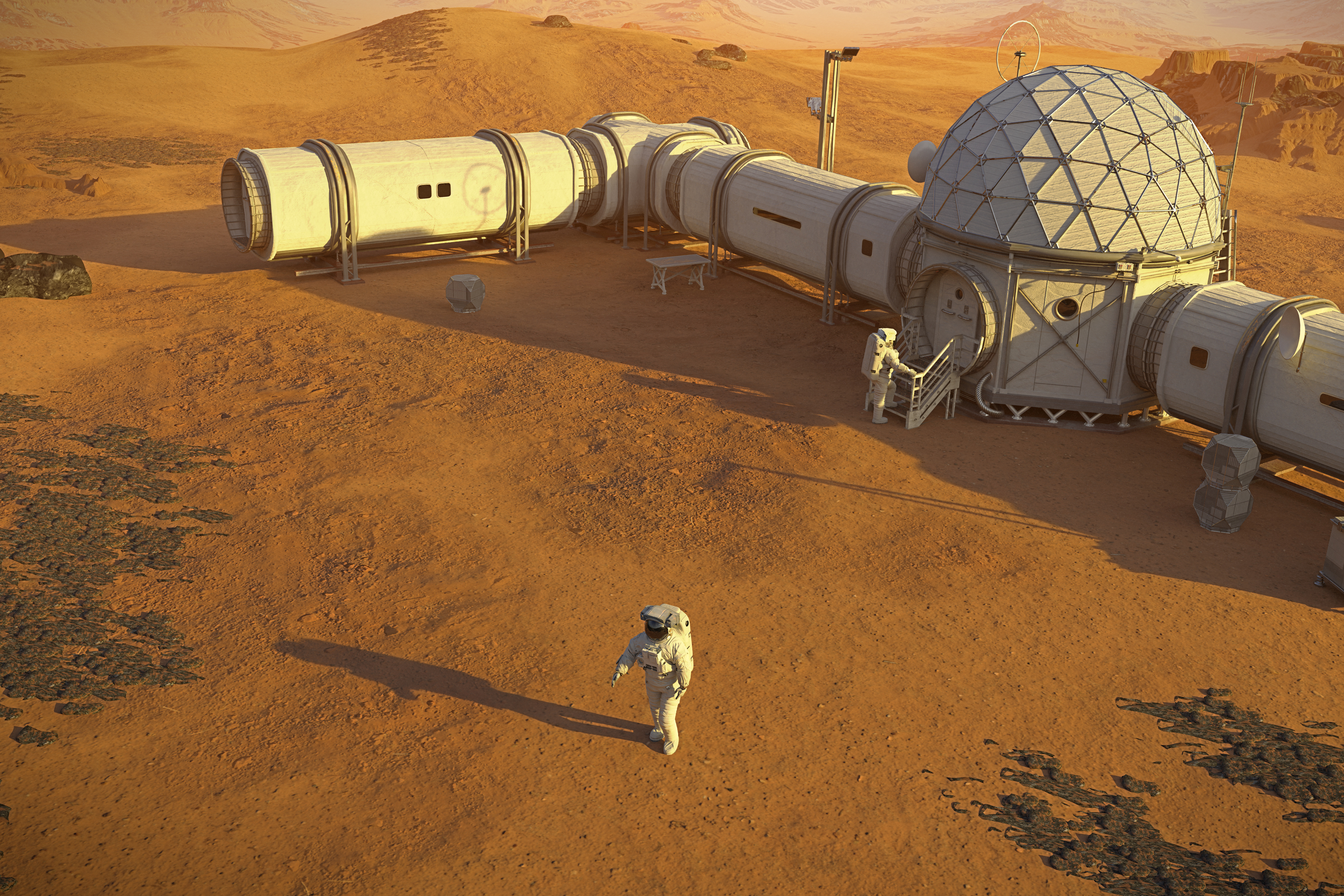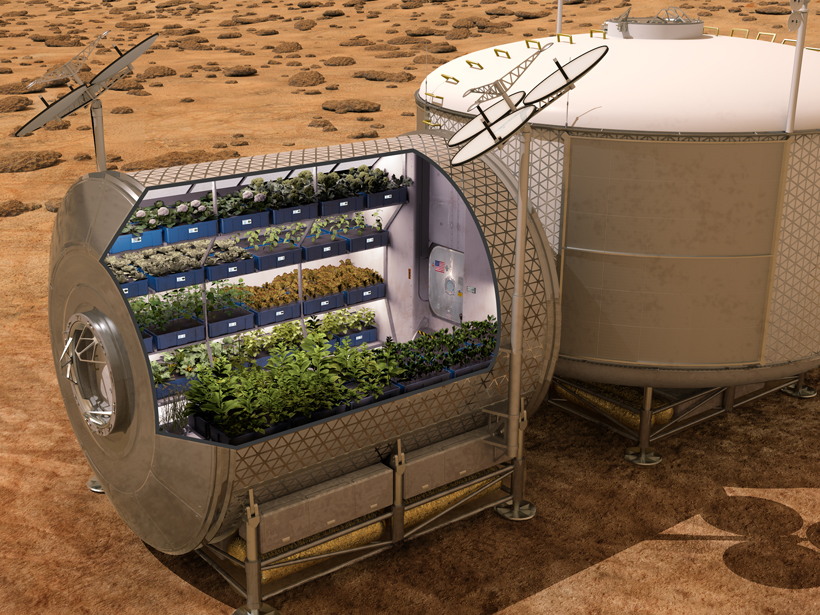- Macro- and microstructural changes in cosmonauts' brains after long-duration spaceflight
- Space radiation and cataracts in astronauts
- Radiation Effects on Astronautic Fertility in Space: Deep Space Policy
- Myocardial Disease and Long-Distance Space Travel: Solving the Radiation Problem
- Small Tissue Chips in Space a Big Leap Forward for Research
- In 1947, six people on a raft, the Kon-Tiki, successfully crossed from Callao (Peru) to the Polynesian archipelago of the Tuamotus. They wanted to demonstrate that Polynesia may have been populated from South America. The crew travelled 8,000 km in three and a half months.
- Three Russians, one French, one Chinese and one Colombian.
- Psychological countermeasures in manned space missions
- The Center for the Utilization of Biological Engineering in Space (CUBES)
Medical Science to Conquer Mars
We're almost there, but medicine faces many challenges before humans can land on the Red Planet.
Article translated from the original French version
The human journey to Mars is so ingrained in the collective consciousness that it seems almost astonishing that to this day the project is only pie in the sky. In fact, numerous obstacles prevent would-be settlers from seeing the breathtaking cliffs of Valles Marineris and thus the deepest canyon in the solar system for themselves.
One of the obstacles to such a long voyage is of medical nature. How can we ensure the physical and mental health of the crew, who will be exposed to an extremely hostile environment on board the spacecraft? How can the health of the astronauts be maintained after their arrival at their destination?
The Voyage to Mars
The entire flight is carried out with the propulsion system turned off in order to save fuel for the two crucial phases: acceleration to take-off and deceleration. This means that the six to nine months of travel in interplanetary space will be spent in zero gravity. At this point, the position of the planets and their distance to one another determine the time of travel. While Earth needs one year for one orbit around the sun, Mars needs 1.9 years. The ideal point in time for a journey returns every 26 months. This is when the planets come closest to each other.
Over the last 20 years, experiments on the International Space Station (ISS) have yielded a lot of information about the human body's adjustments to weightlessness. Bone and muscle atrophy can be counteracted by exercising for several hours a day. However, other problematic phenomena arise in zero gravity, such as the overall distribution of body fluids. These accumulate in the upper body, affecting the visual system, among other things.
As a result, the rear part of the eyeball experiences flattening and inflammation of the optic nerve endings. There are two reasons for this: one, the increased blood pressure, and two, according to the latest research1, the higher pressure of the cerebrospinal fluid. Compression garments are able to keep the blood in the lower part of the body and thus reduce the pressure on the skull.
The longest time an astronaut has ever spent in zero gravity is 878 days over the course of five space missions. That is more than the time allotted for a trip from Earth to Mars. Scientists therefore believe that the methods currently under development on the ISS will enable astronauts to remain relatively healthy on future interplanetary voyages.
Yet, in the event of an urgent medical emergency, the basic medical training provided for the crew of the ISS is inadequate. Nor is there any possibility of emergency evacuation. On board the ISS, a patient is simply taken to a spacecraft docked to the station and treated an hour and a half later by physicians on Earth. However, during a long-distance mission without any possibility of assistance, two real doctors must be part of the crew. This is to ensure redundancy in case one specialist is unavailable. Nobody wants to relive Dr. Rogozov's story.
The further away a spacecraft moves from Earth, the more delayed the communication. Between Mars and Earth, the response time can be over 20 minutes (10 minutes until the message arrives on Earth and the same amount of time until the response is received on Mars). So, in the event of a medical emergency, the crew must act virtually autonomously.

Medical Science on Mars
Upon arrival, the crew is exposed to the extreme strains expected from such an exhausting mission: fatigue, stress and lack of sleep. But there are other small and invisible dangers looming over the explorers.
Mars is an extremely dry environment that is full of abrasive dust, and the electrostatic effect makes it very adhesive. Outside, spacesuits protect the astronauts. The question is, how to prevent this dust from spreading inside the Mars station. Buzz Aldrin was able to describe the "smell" of the moon on his return from Apollo 11 because the astronauts' suits were covered with regolith, the lunar dust. The possible dangers of this dust include skin rashes, eye irritation and possible respiratory diseases.
For human life on Mars, there is one more great challenge that remains hidden from the human eye: radiation. Planet Earth possesses a magnetosphere that protects its inhabitants from the solar wind and, above all, from cosmic radiation. It is made up of highly energetic accelerated electrons, protons and atomic nuclei. In contrast, Mars has cooled down faster than Earth. Its core has solidified and its magnetic field is extinct, which is why the surface of Mars is exposed to cosmic radiation. This is made even worse by the thin Martian atmosphere: it has only about 1% of the density of Earth's atmosphere and keeps out only a tiny fraction of the cosmic particle rain.
Exposure to radiation on Mars is on average 2.5 times higher than for astronauts on the ISS. Long-term exposure to this radiation leads to an increased risk of cancer, degenerative diseases and damage to the nervous system. Radiation also promotes other conditions, such as cataracts2 and infertility3. Most recently, it has been discovered that the heart and cardiovascular system may be sensitive to space radiation as well.4
There is still a lack of research into all the effects of this radiation on human tissue. Advances in this area have been made recently through the development of chips with lab-grown cells that are designed to simulate the reactions of a real organ to different types of stress.5
Mens sana in corpore sano
One particular challenge is maintaining the mental well-being of future space travellers. The isolation and monotonous tasks performed under observation can become a problem for some. Another concern relates to interpersonal conflicts, including the formation of groups and rivalry, which can lead to quarrels within the crew. Thor Heyerdahl, leader of the Kon-Tiki expedition6, identified interpersonal conflicts as the most insidious menace on board. He called the phenomenon "expedition fever".
There has already been research into what may affect the crew's mental state and performance on a space flight to Mars. One of the best-known experiments is the Russian Mars500 programme. Assuming some 250 days to get to Mars, six participants7 lived and worked together for over a year under the restrained supervision of the programme's lead researchers. Apart from the terrestrial air pressure and gravity, their living conditions were similar to those on board a spaceship (isolation, seclusion, 20 minute communication delays, etc.). The highlight of the expedition was when part of the crew simulated a "landing" and spent 30 days in a module that mimicked conditions on the surface of Mars.
Among the more than one hundred tests conducted as part of Mars500 is the experiment EARTH8 (Emotional Activities Related To Health). The goal was to investigate the possible positive effects of virtual reality on the participants' mood and mental well-being. Equipped with headsets, the participants immersed themselves three times a week in a 3D environment that was intended to either relax them or stimulate happy thoughts: natural surroundings, a park with people, and other things. The third part of the programme, the "life journal", allowed participants to keep a diary. Guidance was provided on how to write in order to create the most positive memories possible.
The results proved convincing. According to the "astronauts", they did not feel unhappy during the four-month duration of the experiment. Interestingly, the continuous monitoring during the EARTH experiment showed that the emotional state was stable and that the levels of anxiety and depression remained very low throughout. This is also indicative of how well the candidates for Mars500 were selected.
Prototype hydroponic greenhouse on Mars (Source: NASA)
A Custom-made Gene Pharmacy
One further focus of research is how to produce pharmaceuticals on Mars. Instead of bringing a whole array of medicinal products for all kinds of problems, one could harness the gardens of the Mars base. After all, they already provide some of the food and oxygen needed.
Thanks to advances in precision genome editing, it is not unthinkable that in the future we will be able to synthesise genes carrying the code for any molecule. If these genes are then spliced directly into specific plants, they could produce the desired substances. The Research Institute for Space Technologies CUBES, founded by NASA in 2017, is working on such "programmable plants", among other things.9
Written by Pierre Henriquet
